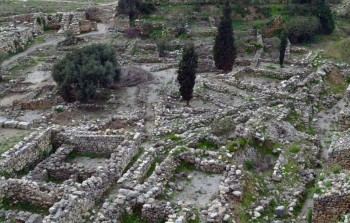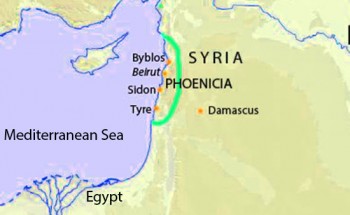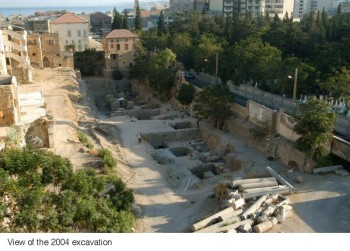Byblos, also known as Gubla, and later Gebal (in the Bible). According to Phoenician legend, Byblos was founded by the God El. Throughout time, they considered it a city of great antiquity. Although its founding is lost within the mists of time, modern scholars believe the site of Byblos is at least 7,000 years old. The current naming of the city and state can be lain at the feet of the Greeks. Sometime after 1200 B.C., they gave the region the name of “Phoenicia”, referring to the coastal area. Phoenicians called the city “Byblos”. On the Mediterranean coast, 23 miles north of Beirut, lay Byblos. It can be found close to the modern Jebail. The Dog River’s headland separates the two cities. In ancient times, it served as an important defensive barrier. Many conquerors documented their passage across the high limestone cliffs. The river, being tremendously fast and having many high waterfalls, made it necessary for travelers to go around. This defense was a double-edged sword, however and caused Byblos to fall into disuse. The camel became the vehicle of choice for transportation and could not easily surpass the raging river. Cities with easy trails became routes of choice, bypassing Byblos. By the time ships came into use by the Greeks and Romans, Byblos was overshadowed by Tyre and Sidon.
About 5 miles south of Byblos is the Nahr Ibrahim, recognized in ancient times as the Adonis River. An antiquated road leads up a treacherous track to the village of Afqa. Located within this small town was the famous Temple of Aphrodite.
Byblos can boast about being the site in which the oldest fully intelligible Canaanite alphabetic text was found. It contained a five-line inscription revealing the construction of a wall by one of the kings the city. The characters, dating from 1000 BC, are more ancient. With this text, using twenty-two characters, the Phoenicians from Byblos originated the linear alphabet system that is the origin of the modern western alphabet. The Pharaohs of the Old Kingdom of Egypt had a sporadic command over trade routes in Palestine and Syria. At Byblos, they had an important merchant colony. Byblos had timber, tin and resin to trade with Egyptian ships carrying papyrus. During the time, Byblos became an important commercial center for exportation of papyrus. According to information’s that can be found in Bible it can be concluded that people of Byblos were great boat builders and well-versed in the maritime skills.



Byblos was the capital of the Giblites people, or ‘mountaineers’. Giblitest peoples were the leading tribe of Lebanon in the days of Joshua. Research about the Giblites people shows they appeared to have been an educated and enterprising people. They were even King Solomon’s chief architects when he built the Temple.
Not only were they great architects, but the Giblites were also famous ship-builders. This is known because the ancients of Byblos were the leading men in the dock-yards of Tyre. Apparently, Giblites were members of the same race to which the Hamites and Semites of later times belonged.
20-19th cent. –Mention in both early and late Execration texts.
1400-1350 –City-kingdom according to el-Amarna letters.
pre-1280 –Mentioned in Papyrus Anastasi I.



c.1100 –Journey of Wen-Amon.
c.1000 –The oldest fully intelligible Canaanite alphabetic text.
333 –Campaign of Alexander: Byblos surrendered without resistance.
Sidon
Scientists believed that area of Sidon was inhabited probably around 4000 BC in Neolithic period. Sidon as the Phoenician city was built on a cape facing an island, which protected its fleet from bad weather conditions. Sometimes Sidon served as a refuge center during military incursions from the interior. In its wealth, commercial initiative, and religious significance, Sidon during the time surpassed all other commercial city states of Phoenicia.
Sidon was twice destroyed in war between the 7th and 4th centuries BC. and again during the earthquake in the 6th Century AD.



Geographically position of Sidon was quite good for Phoenician because on east were highlands with altitudes from 2000 to 2600 feet, but still dissected enough to allow merchants to travel on the eastern territories, in first place traveling to Damascus.
The Sidonian depression, a geological line of weakness, strikes to the southeast, and finally in the north ending the Lebanon Mountain range and providing usable trade routes inland.
The hills are for the most part limestone and chalk, so the forests were not thick. The city was cited on a low hill and a wall separated the city from attack by land.
Production of glass was Sidon’s most important enterprise in the Phoenician era. This production of glass conducted on a vast scale and the production of purple dye in which Phoenicians was famous. The small shell of the Hexaplex trunculus (or Murex trunculus) was broken by artisan in order to extract the pigment that was so rare it became the mark of royalty.
Textiles were produced in Sidon using the dye and traded in all parts of the ancient world. Production of textiles in Sidon were flourished. It was later found that the sands from the area produced an excellent transparent glass, and this glass was a prized commodity throughout the Near East.
Brief historical facts
| Year (BC) | Historical fact |
| 1400-1350 | City kingdom according to el-Amarna Letters. |
| 1280 | Mentioned in papyrus Anastasi I. 11th cent. Journey of Wen-Amon passes thru Sidon. |
| 1050 | Philistines destroyed Sidon; inhabitants fled to Tyre.
|
| 980 | Joab’s census …reaches Sidon |
| 841 | Campaign of Egyptian pharaoh Shalmaneser III |
| 806 | Campaign of Adad-Nirari III to Damascus. |
| 701 | Sidon submitted to Sennacherib; Luli, king of Sidon, fled. |
| 677 | Sidon revolted against Esarhaddon and lost. |
| 351 | Persian king Artaxerxes II (404-358) besieges Sidon; city burnt completely. |
| 333 | Sidon surrenders to Alexander the Great without resistance. |
| 320 | Ptolemy (by sea) and Nicanor by land occupied Sidon |
| 315 | Antigonus and Ptolemy fight back and forth thru Phoenicia. |
| 246-217 | Ptolemy and Seleucis fight back and forth. |
| 200 | Armies of Ptolemy IV were defeated; Scopas flees to Sidon. |
| 163 | Sidon remains faithful to Antiochus during Maccabean revolt. |
